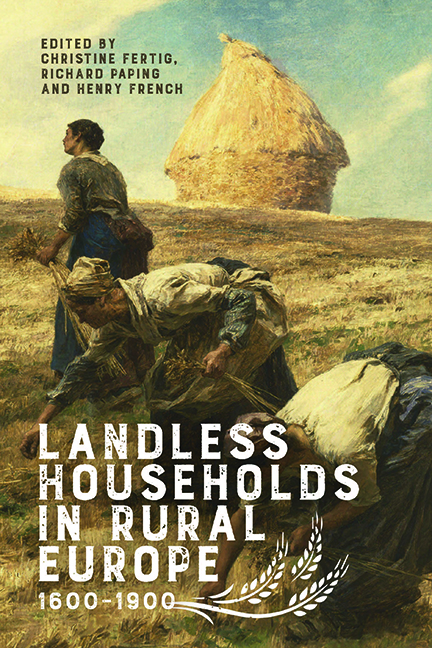Book contents
- Frontmatter
- Contents
- List of Illustrations
- Notes on Contributors
- Preface
- Introduction
- 1 The Treballadors of Girona: Evidence of the Emergence of Wage Labour in Early Modern Catalonia in the Sixteenth and Seventeenth Centuries
- 2 The Squatter Economy of the English Countryside: Building New Landless Communities in England, c. 1600–1900
- 3 The Rise of Landless Households in the Dutch Countryside, c. 1600–1900
- 4 ‘Gaining Ground’ in Flanders after the 1840s: Access to Land and the Coping Mechanisms of Landless and Semi-Landless Households, c. 1850–1900
- 5 Strategies of Survival, Landlessness and Forest Settlement in Flanders: The Forest of Houthulst in a Changing Landscape of Survival (c. 1500–1900)
- 6 Landless and Pauper Households in England, c. 1760–1835: A Comparison of Two Southern English Rural Communities
- 7 Landless Rural Households in France, 1852–1910
- 8 Survival in a Hostile Agrarian Regime: Landless and Semi-Landless Households in Seventeenth-Century Sweden and Finland
- 9 Farming Craftsmen? Access to Land and the Socio-Economic Position of Rural Artisans in Early Modern Finland
- 10 Landlessness and Marriage Restrictions: Tyrol and Vorarlberg in the Eighteenth and Nineteenth Centuries
- 11 Cottages, Barns and Bake Houses: Landless Rural Households in North-Western Germany in the Eighteenth Century
- Bibliography
- Index
- Boydell Studies in Rural History
9 - Farming Craftsmen? Access to Land and the Socio-Economic Position of Rural Artisans in Early Modern Finland
Published online by Cambridge University Press: 08 October 2022
- Frontmatter
- Contents
- List of Illustrations
- Notes on Contributors
- Preface
- Introduction
- 1 The Treballadors of Girona: Evidence of the Emergence of Wage Labour in Early Modern Catalonia in the Sixteenth and Seventeenth Centuries
- 2 The Squatter Economy of the English Countryside: Building New Landless Communities in England, c. 1600–1900
- 3 The Rise of Landless Households in the Dutch Countryside, c. 1600–1900
- 4 ‘Gaining Ground’ in Flanders after the 1840s: Access to Land and the Coping Mechanisms of Landless and Semi-Landless Households, c. 1850–1900
- 5 Strategies of Survival, Landlessness and Forest Settlement in Flanders: The Forest of Houthulst in a Changing Landscape of Survival (c. 1500–1900)
- 6 Landless and Pauper Households in England, c. 1760–1835: A Comparison of Two Southern English Rural Communities
- 7 Landless Rural Households in France, 1852–1910
- 8 Survival in a Hostile Agrarian Regime: Landless and Semi-Landless Households in Seventeenth-Century Sweden and Finland
- 9 Farming Craftsmen? Access to Land and the Socio-Economic Position of Rural Artisans in Early Modern Finland
- 10 Landlessness and Marriage Restrictions: Tyrol and Vorarlberg in the Eighteenth and Nineteenth Centuries
- 11 Cottages, Barns and Bake Houses: Landless Rural Households in North-Western Germany in the Eighteenth Century
- Bibliography
- Index
- Boydell Studies in Rural History
Summary
In the winter of 1823, the parish tailor Jacob Sahlstedt was accused of theft in the local district court. He had broken into his neighbour's house (with a female accomplice) and among other things had stolen a bottle of spirits – footprints in the snow were interpreted as proof of their wrongdoing. In court, the couple eventually pleaded guilty and were sentenced to prison. While the tailor was incarcerated in Hämeenlinna castle, his landlord, the landholding farmer Carl Rekola, cancelled his tenancy agreement. A copy of the lease, dated 1809, survives in the court records, and it reveals that the tailor had agreed to do all the tailoring required by the Rekola household and in return for his labour gained access to a small plot of land (9 acres) and a room to live in (along with a sauna). However, because of his prison sentence and loss of reputation, he lost his lease and was evicted from his home.
Most craftsmen in rural Finland were so-called parish artisans like Jacob Sahlsted. Formal recognition of their status required a licence to work (granted by the provincial governor) and the obligation to pay a special craft tax. There were also other kinds of artisans in the countryside, such as village blacksmiths and craftsmen working in manor houses. Some of these people lacked an officially acknowledged status, but they made handicraft products all the same. Some peasants also plied a trade, but they were registered as peasants rather than artisans, because it was considered more prestigious to be a landowning farmer. As a result, Finnish artisans were by no means a homogeneous group and their esteem varied according to their position within this group. However, the special skills possessed by some craftsmen meant that they were held in higher regard than other non-landed households, and often had access to land. This chapter will examine artisans’ opportunities to engage in agriculture: discussing which of them had access to land and in what circumstances. Next, it will review the general position of artisans in local society, especially by looking at the marriage markets and godparent relations.
In early modern Finland, the ownership of land was legally restricted and connected to villages and the possession of whole estates or farms because the Crown did not want landownership to be divided into small parts.
- Type
- Chapter
- Information
- Landless Households in Rural Europe, 1600-1900 , pp. 220 - 242Publisher: Boydell & BrewerPrint publication year: 2022



